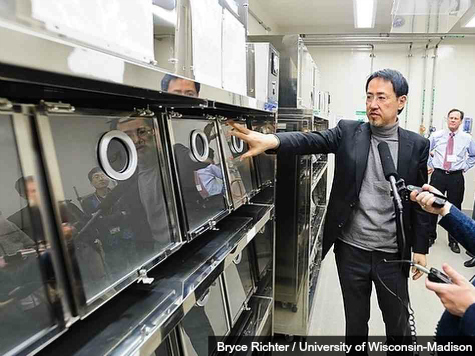In a frightening scenario straight out of the movies, a University of Wisconsin-Madison scientist has genetically changed the 2009 strain of pandemic flu, which killed 500,000 people, to enable it to escape the body’s immune system.
After the 2009 virus ravaged the world community, most people developed an immunity to it so that it became less dangerous. Yoshihiro Kawaoka’s early experiments were designed to change the 2009 virus to its pre-pandemic state so he could see how it changed and got free of the immune system. Now his work has been to select strains of the virus that bypass the defenses humans have created in response to the virus.
Kawaoka has not released his research to the public, but said Tuesday that the details are ready for submission to a scientific journal. He emailed The Independent:
Through selection of immune escape viruses in the laboratory under appropriate containment conditions, we were able to identify the key regions [that] would enable 2009 H1N1 viruses to escape immunity. Viruses in clinical isolates have been identified that have these same changes in the [viral protein]. This shows that escape viruses emerge in nature and laboratory studies like ours have relevance to what occurs in nature.
The only other time Kawaoka mentioned his experiment was earlier this year at a closed scientific meeting, but he would not disclose to The Independent any printed details or lecture slides from his talk. Yet some scientists who attended the meeting were horrified by what they heard. One scientist said:
He took the 2009 pandemic flu virus and selected out strains that were not neutralized by human antibodies. He repeated this several times until he got a real humdinger of a virus. He left no doubt in my mind that he had achieved it. He used a flu virus that is known to infect humans and then manipulated it in such a way that it would effectively leave the global population defenseless if it ever escaped from his laboratory. He’s basically got a known pandemic strain that is now resistant to vaccination. Everything he did before was dangerous but this is even madder. This is the virus.
The prior work that the scientist referenced was the experimentation Kawaoka performed trying to re-create the 1918 flu virus and attempting to ease the transmissibility of a highly lethal strain of bird flu.
Although the new experiment was performed at Wisconsin University’s $12 mullion Institute for Influenza Virus Research in Madison, built specifically to house Professor Kawaoka’s laboratory, there are concerns about the safety of the project. The laboratory features a level-3-agriculture category of biosafety, one level below the top safety level for lethal pathogens such as Ebola virus, but the experiment was conducted at the lower level-2 biosafety.
The university insists that there is little or no risk of the virus escaping, but a similar US Government lab at the Centers for Disease Control and Prevention in Atlanta exposed at least 75 workers to a possible anthrax infection despite its level-3 biosafety rating, according to The Independent.
Wisconsin’s Institutional Biosafety Committee condoned the experiment, but some members asserted that they had not been apprised of the antibody study on pandemic H1N1, which began in 2009, and they were deeply disturbed.
Professor Tom Jeffries warned:
I have met Professor Kawaoka in committee and have heard his research presentations, and honestly it was not re-assuring. What was present in the research protocols was a very brief outline or abstract of what he was actually doing… there were elements to it that bothered me. I’m a distinct minority on this committee in raising objections. I’m very uneasy when the work involves increasing transmissibility of what we know already to be very virulent strains.
When asked his opinion of the attempt to create a pandemic strain of flu that was intended to escape the human immune system, Professor Jeffries asserted: “That would be a problem.”
Rebecca Moritz, who is responsible for supervising Wisconsin’s work on “select agents” that could include an influenza virus, defended Kawaoka’s work, arguing that the results could yield a better vaccine in the future:
With that being said, this work is not to create a new strain of influenza with pandemic potential, but [to] model the immune-pressure the virus is currently facing in our bodies to escape our defenses. The work is designed to identify potential circulating strains to guide the process of selecting strains used for the next vaccine…The committee found the biosafety containment procedures to be appropriate for conducting this research. I have no concerns about the biosafety of these experiments.
Kawaoka said that he has offered some of the initial results of his experiment to the World Health Organization, and they were “well received.” He added:
We are confident our study will contribute to the field, particularly given the number of mutant viruses we generated and the sophisticated analysis applied. There are risks in all research. However, there are ways to mitigate the risks. As for all the research on influenza viruses in my laboratory, this work is performed by experienced researchers under appropriate containment and with full review and prior approval by the (biosafety committee.)

COMMENTS
Please let us know if you're having issues with commenting.